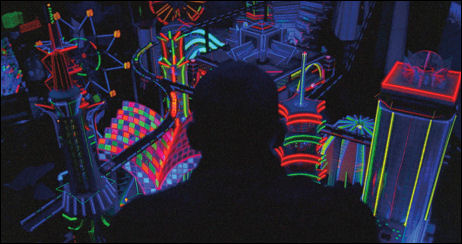“I know what it’s like to be dead” is one of John Lennon‘s more famous lyrical lines. Now, with his Cannes-screened Enter The Void, director Gaspar Noe has also laid claim to having an imaginative knowledge of the after-realm, which might be summarized as “I know what it’s like to be dead and reborn.”

And it’s fascinating, to hear it from Moving Pictures magazine’s Eric Kohn. The problem, however, is that “no movie in recent memory [has] simultaneously outstayed its welcome and felt so fresh in nearly every scene.
“In a rare film accomplishment, No√©’s Enter the Void inspires feelings of awe, disgust, contemplation and annoyance — sometimes all at once,” he observes.
“The movie begins from the perspective of a young, American drug dealer named Oscar (Nathaniel Brown), who lives in Tokyo with his sister (Paz de la Huerta). The camera adopts his perspective, jutting to black as it mimics his blinks and even muffling his voice to make it sound like the viewers are inside his head.
“The downbeat stoner gets high and heads out to a bar with a friend. Along the way, they have a cosmic discussion about the Tibetan Book of the Dead, sounding like a couple of aimless druggies with little connection to reality. But their discussion ends up having highly profound implications. Soon, the dealer is dead, lying in a pool of his own blood in the bathroom of the bar. And yet the camera maintains his perspective, and that’s when things start to get really far out.
“Oscar’s viewpoint drifts out of his body to explore his surrounding environment, where he witnesses the fallout of his demise.
“His sister, an erotic dancer whose seedy lifestyle caused Oscar to become a drug addict in the first place, veers into depression. Meanwhile, Oscar starts to think back on his childhood before flashing back to modern times, witnessing some nifty-looking colors and ultimately getting reborn as the spawn of his sister and best friend. Trust me, spoilers are important when recommending No√©’s movie. It’s worth seeing simply for its intense application of one gimmick the whole time, but you need to know that it does end after a while — after two hours and 30 minutes, actually.
Borrowing from the aesthetics of Cloverfield, first-person shooters and the extreme long-take style of Mike Figgis‘ Timecode, Noe’s audacious work begs for big-screen treatment, a patient audience and a willingness to give the director a certain amount of leeway. In concept, it’s just plain dumb. In execution, it’s somewhat pretentious and far too ambitious. In the right frame of mind, however, Enter the Void offers a wholly original twist on the role of spectatorship in storytelling. Love it or hate it, the movie succeeds as a radical experiment in film form.
“When the flashbacks begin (and the movie adopts a third-person view), Noe settles into a relatively basic pattern, jumping back and forth from Oscar’s memories to his perspective in the present. Then, right when you expect the director to wrap things up, it gets even nuttier. We are given the privilege — if it can be described in that manner — of witnessing Oscar’s re-conception as it happens, including a shot from inside his sister’s womb as a penis enters her and shares the seed that will bring him back to the world. It’s like Look Who’s Talking gone NC-17 and avant-garde.
“Beyond its unique construction, Enter the Void also functions as a dedicated provocation. With loads of graphic sex and even an onscreen abortion, the movie led many in its Cannes audiences to suggest that it ups Lars von Trier‘s Antichrist as the most controversial entry at the festival. Maybe, but it’s the core idea of the production — death as the ultimate drug trip — that ought to take the spotlight.”












